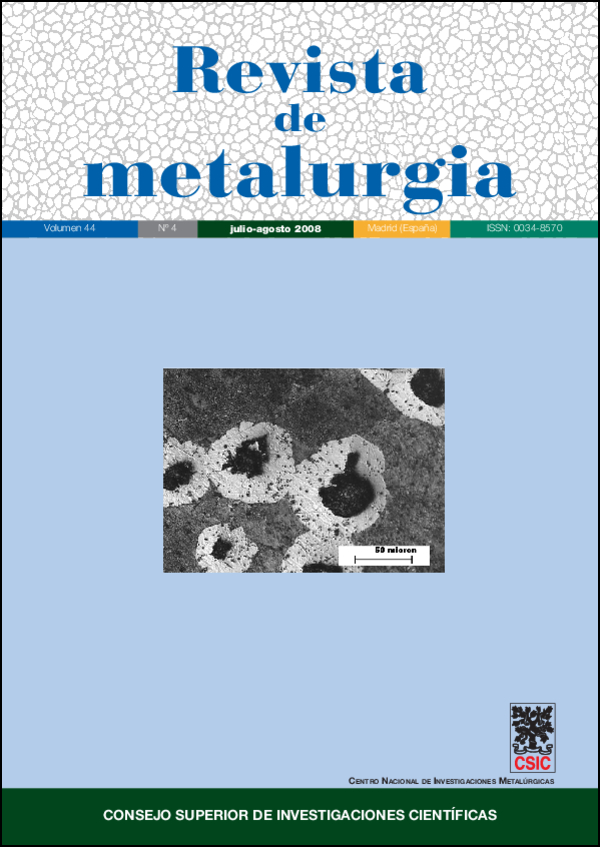Research upon the quality assurance of the rolling-mill rolls and the variation boundaries of the chemical composition
DOI:
https://doi.org/10.3989/revmetalm.2008.v44.i4.125Keywords:
Rolls, Alloyed elements, Hardness, Chemical composition, Mathematical modelingAbstract
The cast-iron rolls must present higher hardness at the rolling surface and lower in the core and the necks, adequate with mechanical resistance and in the high work temperature. If in the zone of the rolling surface, the hardness is guarantied by the irons structure, through the cementite quantities, the core of rolls must contain graphite, to assure this property. Starting from the lamination equipments aspects, from the form of rolls, of the technological interest zones and the structure, which assures the exploitation property, it was establish, through modeling, to the mathematical description of a direct influences, and in final, through successive determinations, to an optimum. One of the parameters, which are determined the structure of the irons destined for rolls casting, is the chemical composition, which guaranties the exploitation properties of the each roll in the stand of rolling mill. The realization of optimum chemical compositions of the cast-iron can constitute a technical efficient way to assure the exploitation properties, the material from which the rolling mills rolls are manufactured having an important role in this sense. Although the manufacture of rolls is in continuously perfecting, the requirements for superior quality rolls are not yet completely satisfied, in many cases, the absence of quality rolls preventing the realization of quality laminates or the realization of productivities of which rolling mills are capable. This paper presents an analysis of the main alloying elements from chemical composition, the influences upon the mechanical properties of the cast-iron rolls, and presents also some graphical addenda. Using the Matlab calculation and graphical programs we determinate some correlations between the hardness (on the working surface and on necks) and the chemical composition. Using the double and triple correlations is really helpful in the foundry practice, as it allows us to determine variation boundaries for the chemical composition, in view the obtaining the desired and optimal values of the hardness of this very important metallurgical equipments. The enunciation of some mathematically modeling results, described through a number of multi-component equations determined for the spaces with 3 the and 4 dimensions, as well as the generation of some regression surfaces, of some curves of levels and volumes of variation, can be represented and interpreted by technologists and can be considerate diagrams of correlation between the analyzed variables. From this point of view the research is inscribes in context of scientific capitalization of the process and the industrial technologies optimizations, on the way of the analysis and the mathematical experiment.
Downloads
References
[1] N.A. Budaghiant¸ and V.E. Karsski, Cilindrii de laminor turnat¸i, Ed. Tehnicaˇ, Bucures¸ti, 1986.
[2] Gh. Chelu, Modelarea s¸i optimizarea proceselor de prelucrare plasticaˇ la cald, Ed. BREN, Bucures ¸ti, 2000.
[3] M. Ghinea and V. Firet¸ eanu, Matlab. Calcul numeric – graficaˇ – aplicat¸ii, Ed. Teora, Bucures¸ti, 1999.
[4] D. Taloi, C. Bratu, E. Florian and E. Berceanu, Optimizarea proceselor metalurgice, Ed. Didacticaˇ s¸i Pedagogicaˇ, Bucures¸ti, 1983.
[5] I. Kiss, the quality of rolling mills rolls cast by iron with nodular graphite, Mirton, Timisoara, 2005.
[6] *** Romanian Standards for cast-iron rolling mills rolls.
[7] C. Pinca-Bretotean, I. Kiss, T. Heput and O. Tirian, J. Mech. Eng. 3 (2004) 177-188.
[8] I. Ripos¸an, V. Docean and A. Mitrofan, Metal. 3 (1989) 138-142.
[9] L. Sofroni, Metal. 10 (1983) 397-408.
[10] L. Sofroni, I. Ripos¸an, I. Chira and V. Brabie, Metal. 10 (1983) 473-478.
[11] I. Kiss and St. Maksay, Metalurgia Int. 2 (2005) 14-21.
[12] I. Kiss and St. Maksay, 6th Int. Symp. Young People Multidisciplinary Research, Sudura Printing House, Timisoara, 2004, pp. 176-185.
[13] I. Kiss and St. Maksay, J. Mech. Eng. 1 (2005) 17-22.
[14] I. Kiss, I. Ripos¸an and St. Maksay, Ann. Fac. Eng. Hunedoara 2 (2005) 193-201.
[15] I. Kiss, V. Alexa and S. Ratiu, 4th Int. Symp. KOD, Palic, Serbia and Montenegro, 2006
[16] I. Kiss and St. Maksay, Ann. Fac.Eng. Hunedoara 4 (2006) 77-82.
Downloads
Published
How to Cite
Issue
Section
License
Copyright (c) 2008 Consejo Superior de Investigaciones Científicas (CSIC)

This work is licensed under a Creative Commons Attribution 4.0 International License.
© CSIC. Manuscripts published in both the printed and online versions of this Journal are the property of Consejo Superior de Investigaciones Científicas, and quoting this source is a requirement for any partial or full reproduction.
All contents of this electronic edition, except where otherwise noted, are distributed under a “Creative Commons Attribution 4.0 International” (CC BY 4.0) License. You may read the basic information and the legal text of the license. The indication of the CC BY 4.0 License must be expressly stated in this way when necessary.
Self-archiving in repositories, personal webpages or similar, of any version other than the published by the Editor, is not allowed.
















